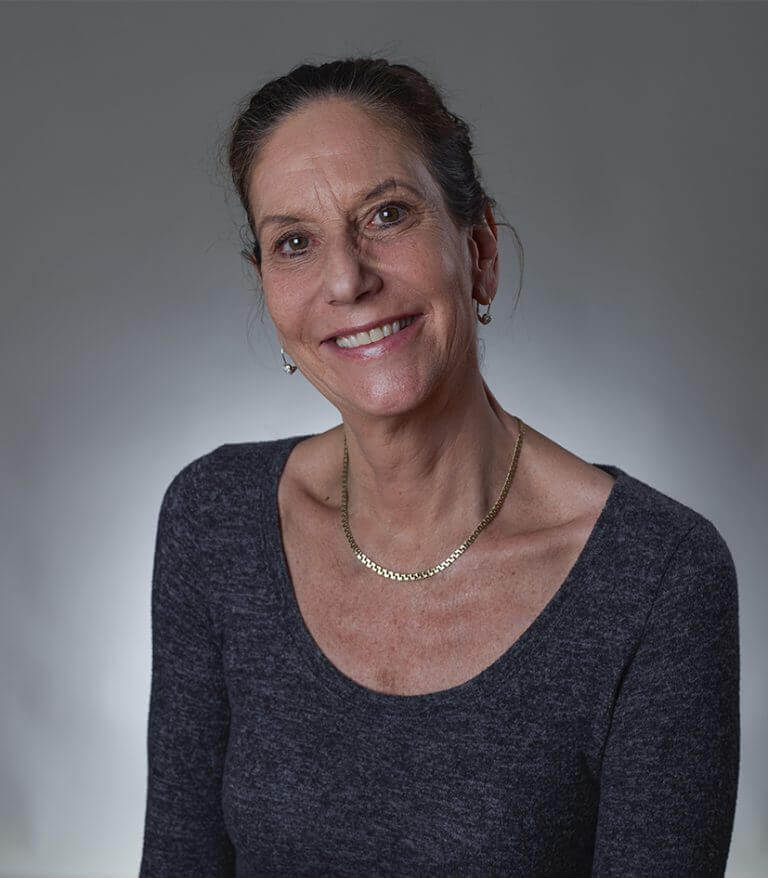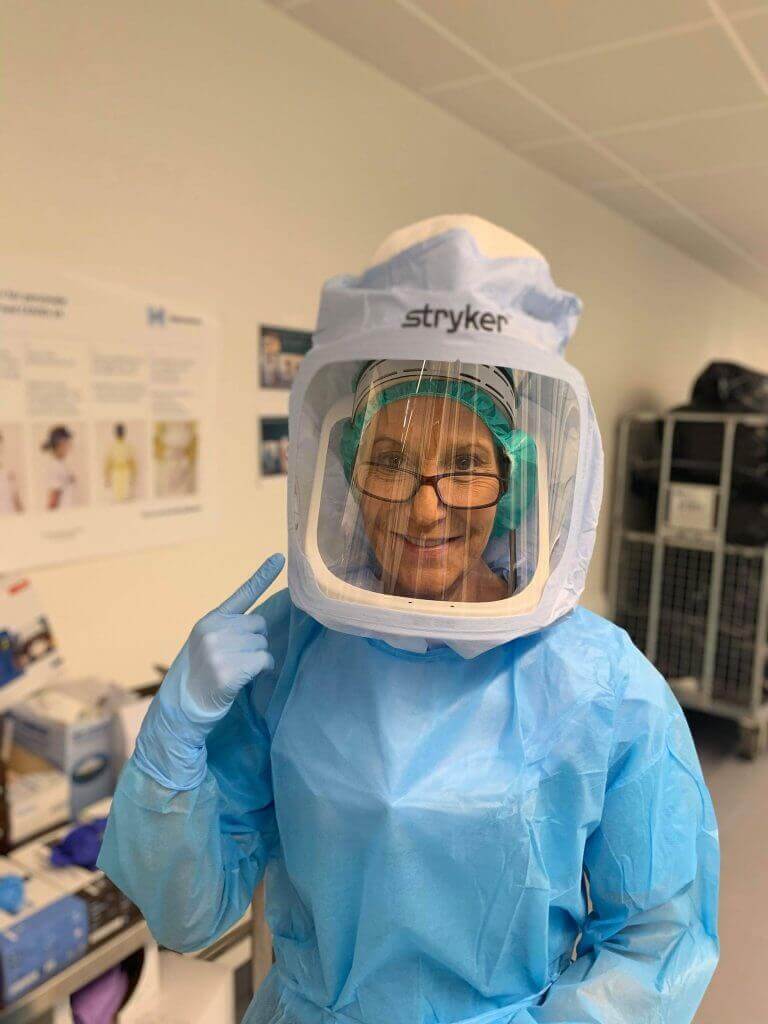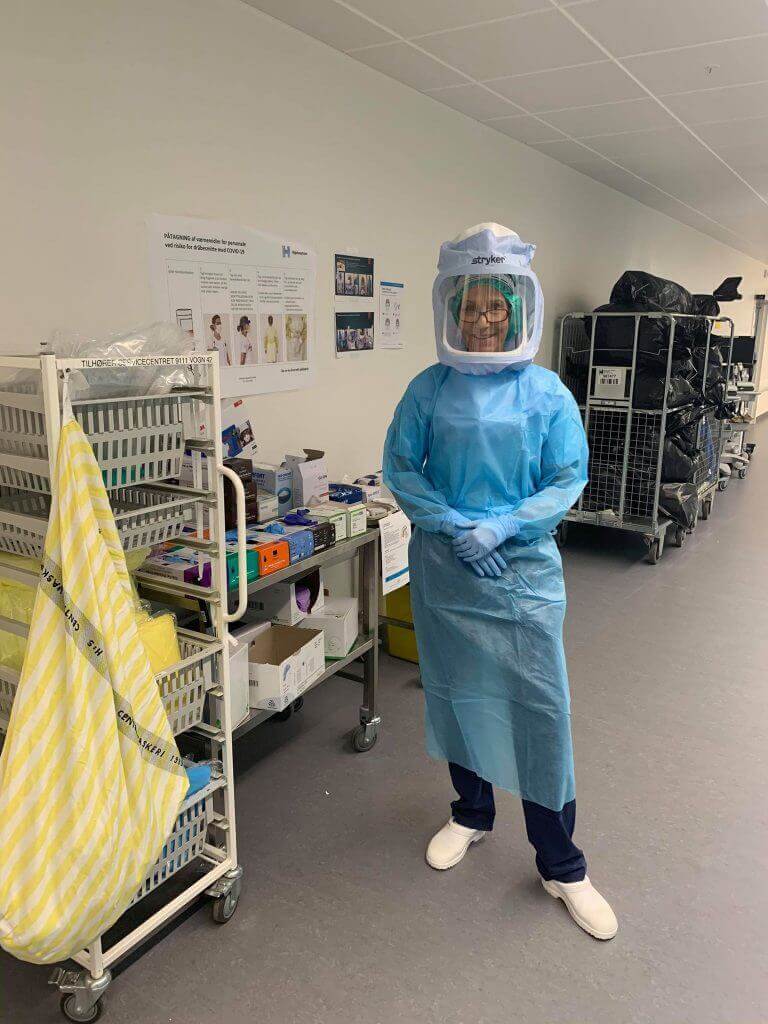There was no easing into their workday for Susan S. and the rest of the nursing staff in the COVID-19 intensive care unit (ICU) at their hospital in Copenhagen, Denmark. At the beginning of every shift, they would gather to review a large chart with the latest patient information. There were three categories listed: new patients, patients who had been transferred out to other departments, and patients who had died.
“That’s where it was tough,” Susan said. “It was like, ‘Oh, another one. We lost another one.’”
Susan, who has been with Cook for 13 years, moved into a new role in the Vascular Division as a team lead on Access Technologies for Europe, Middle East, and Africa (EMEA). It is the latest in a series of different roles and responsibilities she has had since joining the company. But Susan started her work life as a nurse, focusing at various times on the ICU, anesthesiology, trauma, and the emergency room. Even after she started working for a pharmaceutical company and, later, other medical device manufacturers, Susan continued to work some nights, weekends, and holidays in hospitals.
Her interest in the profession started early, when as a seven-year-old she would sometimes help care for an uncle who had severe health issues.
“After that, I always looked for someone or something I could be a nurse to,” Susan said. “I wanted to help people, and I wanted to make a difference. That was my goal all the time.”
11 years ago, though, she decided it was time to hang up her nursing scrubs.
Call to action
In March of 2020, as the COVID-19 virus started moving into Europe, the Danish government asked former nurses and doctors to volunteer to go into a database that would allow them to be contacted in case they were needed to help treat patients.
Susan signed up for two locales—the Danish capital of Copenhagen and the area where she now lives, which is about an hour outside of Copenhagen. Within 24 hours, a hospital in Copenhagen reached out to her to get a better understanding of her experience and areas of expertise.
“I was explaining that it had been many, many years since I’d done nursing, but if I can do anything to help, I’m willing to do that,” Susan said.
She immediately went to her manager and then to Human Resources.
“I told them that I felt I needed to do that—for me, it was the right thing to do,” Susan said.
Twenty-four hours after their initial conversation, the hospital called Susan back and said they needed anesthesia and ICU nurses. They wanted her to work in a newly opened COVID-19 ICU at their facility where the most critical COVID-19 patients would be cared for—and they needed her to go through orientation the next day. It was no surprise that Susan was up for the challenge.
Risks and sacrifices
As excited as she was about the opportunity to once again be working directly with patients, Susan knew her decision could negatively impact her home and family life—not to mention her own health.
Her elderly parents were dealing with medical issues of their own, which required trips to the hospital. Susan also needed to quell the fears of her adult children, who were concerned about their mother exposing herself to COVID-19. Lastly, because she would be working with patients who had tested positive for the virus, Susan, who lives alone, was going to have to stay quarantined in her house when she was not at the hospital. For someone who thrives on social interaction, this was no small ask.
Ultimately, though, Susan decided the risks and the sacrifices were worth it for the chance to make a difference for the COVID-19 patients.
And she was able to make the best of the situation.
“I had coffee with one of the people who lives next to me, who is actually a Cook employee, outside with three meters distance between us,” Susan. “That was my only contact during the time that I was there at the hospital. It was a very quiet time—I was almost totally isolated.”
A nurse again
It all happened at a furious pace. She went through a half-day orientation session, followed the next day by her first shift in the COVID-19 ICU where Susan shadowed another nurse. She was then placed with an anesthetic nurse who was already on staff at the hospital. After two shifts of training, Susan was assigned her own patients.
In many ways, it was like she had never been out of the hospital. Muscle memory kicked in, and Susan somewhat seamlessly found herself getting into the daily flow of caring for the people in her area.
“I felt myself go back to my old basics—you know, I’m not afraid of this intubation tube,” she said. “I can talk to a patient, I can hold their hand if the patient is dying. It was a little bit like going back in time.”
But between the strict protocols that had been put in place because of COVID-19 and some of the technological advancements that had occurred since she was last in a hospital, there were also some challenging moments.
For starters, everyone entering the ICU had to do an alcohol wash multiple times before and after putting on their personal protective gear, which included a face shield that encircled the wearer’s entire head and was tucked into the top of their PPE gown. While it kept germs out, it also trapped body heat.
“It was pretty warm and uncomfortable and not very easy to work with,” Susan said.
She learned that lesson her first day when she was trying to read a database screen.
“I took my reading glasses with me, but when you have protection gear on, you can’t adjust them,” Susan said. “I had to have my nose all the way to the screen to read the screens. From then on, I would wear my glasses under my PPE halfway down my nose.”
Navigating the databases was something she hadn’t had to do during her previous career as nurse. Rather than get frustrated, though, Susan approached it with a philosophy that she was able to employ during the entire month she spent working in the ICU—no matter what the situation, she was going to be transparent with herself about whatever she was doing or feeling.
“I just needed to be honest and say, ‘I can’t do this’ or ‘I’m not comfortable,’” Susan said. “Don’t pretend that you know everything. After that, I had no stress, no frustration, I don’t think I had a rise in my heartbeat. I had a job to do, and I needed to do it because it needs to be done, and no one else can do it right now—so I just need to do it.”
Thankfully, she found herself in an extremely supportive environment.
“Whenever we had questions, we would all help each other out,” Susan said. “That was the team spirit that I really felt. Helping each other through this experience of being out of our comfort zones.”
A new day, everyday
 Her hour-long drives home from the hospital after a shift were usually spent in conversation with her daughter, who would check in to see how Susan’s day had gone. Those calls were also a welcome chance for Susan to “unpack” what she had just been through and decompress after spending an intense eight and a half hours in the ICU.
Her hour-long drives home from the hospital after a shift were usually spent in conversation with her daughter, who would check in to see how Susan’s day had gone. Those calls were also a welcome chance for Susan to “unpack” what she had just been through and decompress after spending an intense eight and a half hours in the ICU.
“I did like I used to do when I was an acute care nurse—give myself time to calm down and be ready to sleep when I got home,” Susan said.
In contrast, the drives to the hospital were her time to mentally prepare herself so that she could be at her best for her patients.
“I did not want to talk to anybody when I went into work,” Susan said. “I would have my coffee with me in the car, and I would just concentrate on the road. Sometimes, I would wonder what the day would be like and how many patients are still alive.”
“I wouldn’t think about if I could manage it or not,” she continued. “I wondered more about how this day was going to run. But I was actually looking forward to it. It sounds maybe weird, but I was looking forward to going and doing something to make a difference.”
Once she donned her PPE, Susan had to be totally focused on the patients for the next eight and a half hours.
The physical demands were almost as great as the mental ones. Other than when she was on her two breaks during the shift to eat, drink, and use the bathroom, Susan was on her feet the entire time. The first day, her blood sugar dropped, and she had to leave the ICU to sit down and grab a snack. After that, she made sure she was fueled up and hydrated before her shift.
“It was very hard,” Susan said. “You don’t get out unless you have to use the bathroom. But nurses don’t pee that much, to be honest. Even me, who has a day job where I can go to the bathroom whenever I wanted, got adjusted. You really just have your two breaks, and that’s when you do what you have to do.”
The unpredictability of the COVID-19 virus turned every day into a learning experience for the entire hospital staff. There, the “new normal” was new patients, new symptoms, and new treatments.
“We learned so many things on the way,” Susan said. “And we taught each other along the way. We learned that they get thrombosis easily. We learned that when we turned people onto their stomach they breathed better. We are learning every day. We just kept trying to do better and be better at the patient care. We had to be creative.”
Despite having spent almost two decades in a wide variety of capacities as a nurse, there was nothing in her career that compared to what Susan went through in the COVID-19 ICU. The only experience that was even remotely reminiscent was when she helped rescue people from a sinking boat while on vacation in Thailand.
“The ICU was full; it was really hectic,” she said. “They said it was like a war zone. Everybody was just going from one patient to another. But you keep your face calm—because you are trained to do that—and you react afterwards. I made peace with the situation.”
One of the things that experience had taught her was something that, on the surface, might strike many people as counterintuitive. At the end of her shift, rather than heading straight to her car and driving home, she would instead head to the break room and have a cup of coffee with the other nurses.
“We could all talk a little bit about what had happened with each other and the next shift,” Susan explained. “Again, you take action and then you react afterward.”
After rehashing the experience with her colleagues, she would do so again with her daughter on the drive home.
“My daughter was a huge support. I could talk through things with her,” Susan said. “Sometimes, I would do so again with my neighbor, the other employee with Cook, who I would have my coffee with in the morning.”
 A bittersweet but inspiring ending
A bittersweet but inspiring ending
At the end of April, with COVID-19 cases on the decline in the Danish capital, the decision was made to shut down the ICU Susan had been working in.
The opportunity to impact patients’ lives and the sense of shared purpose with her colleagues had a significant impact on Susan, reminding her of what she was most passionate about.
“The team spirit was amazing—everybody had the same goal,” she said. “It was all about the patient, what can we do for the patient with whatever skills we have and whoever we are. I really loved that.”
“When you all have one goal and you all work in the same direction, you can do things that are amazing,” Susan continued. “It made me realize that you need to put your personal goals behind and go for what is best for the patient. That is something that I will bring further into my work with Cook. It was so energizing.”
